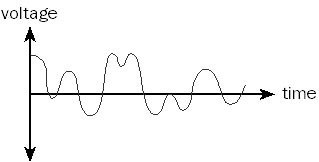Definition of Analog Transmission in Network Encyclopedia.
What is an Analog Transmission?
Analog Transmission is the transmission of signals that vary smoothly with time, as shown in the diagram. An analog signal can take on any value in a specified range of values. A simple example is alternating current (AC), which continually varies between about +110 volts and -110 volts in a sine wave fashion 60 times per second.

A more complex example of an analog signal is the time-varying electrical voltage generated when a person speaks into a dynamic microphone or telephone. Analog signals such as telephone speech contain a wealth of detail but are not readily accessible to computers unless they are converted to digital form using a device such as an analog-to-digital converter (ADC).
Old-fashioned vinyl records store sound information in the form of a continuously varying analog groove, but modern musical CDs store their information in digital form. Some individuals claim that they can actually tell the difference between an analog and a digital recording, and generally, agree that the analog recording sounds «warmer».
Bandpass: In real-world scenarios, filters are used to filter and pass frequencies of interest. A bandpass is a band of frequencies which can pass the filter.
Low-pass: Low-pass is a filter that passes low frequencies signals. When digital data is converted into a bandpass analog signal, it is called digital-to-analog conversion. When low-pass analog signal is converted into bandpass analog signal it is called analog-to-analog conversion.
Digital-to-Analog Conversion
When data from one computer is sent to another via some analog carrier, it is first converted into analog signals. Analog signals are modified to reflect digital data, i.e. binary data. An analog is characterized by its amplitude, frequency, and phase. There are three kinds of digital-to-analog conversions possible:
- Amplitude Shift Keying: In this conversion technique, the amplitude of analog carrier signal is modified to reflect binary data.
- Frequency Shift Keying: In this conversion technique, the frequency of the analog carrier signal is modified to reflect binary data.
- Phase Shift Keying: In this conversion scheme, the phase of the original carrier signal is altered to reflect the binary data.
To learn more read our main article “Digital-to-analog conversion“.
Analog Signals
Analog signals are usually specified as a continuously varying voltage over time and can be displayed on a device known as an oscilloscope. The maximum voltage displacement of a periodic (repeating) analog signal is called its amplitude, and the shortest distance between crests of a periodic analog wave is called its wavelength.
The local loop of the Plain Old Telephone Service (POTS) is limited to carrying sound signals in frequency range from 300 Hz to 3300 Hz (3.3 kHz). This range is suitable for voice communication, but limits the theoretical maximum speed of analog modem transmissions to about 56 Kbps.